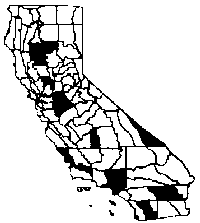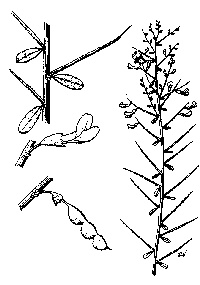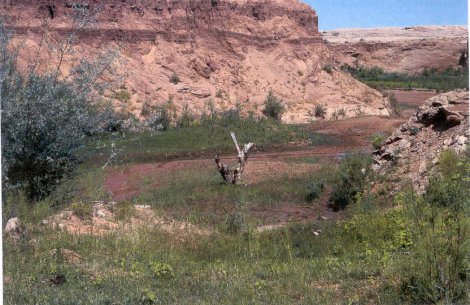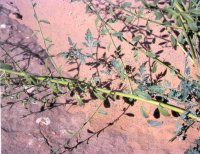|
Alhagi pseudalhagi
|
|
|
|
Scientific name
|
Alhagi pseudalhagi
|
|
Additional name information:
|
(M. Bieb) Desv.
|
|
Common name
|
camelthorn, camels thorn, camel-thorn, Caspian manna, Persian manna
|
|
Synonymous scientific names
|
Alhagi camelorum, A. maurorum, A. persarum
|
|
Closely related California natives
|
0
|
|
Closely related California non-natives:
|
0
|
|
Listed
|
CalEPPC List B,CDFA A
|
|
By:
|
Marc C. Hoshovsky,Ross O’Connell
|
|
Distribution
|
|
|
HOW DO I RECOGNIZE IT?
Distinctive features:
|
Camelthorn (Alhagi pseudalhagi) is a
medium-sized, spiny, intricately branched perennial shrub that grows one and a
half to three feet tall and two to three feet in diameter. It has many rigid
branches armed with numerous sharp yellow-tipped spines (one-half inch to one
and a half inches long). Both flowers and seed pods are borne on thorns. The
small pea-like flowers, ranging in color from brown to red, maroon, and purple,
fade to violet with age. The pea-like seed pods are reddish brown and
constricted between seeds to resemble a string of beads, with the end of the pod
narrowed to a short beak.
|
|
Description:
|
Fabaceae. Stems: rigid, much branched, 1-4 ft (3-12 dm) high, greenish, glabrous, (young branches hairy). Stems have numerous sharp, axillary spines 0.5-1 in (1-2.5 cm) long, with yellow tips, often on short branches. One or more stems produced from each root crown. Leaves: blue-green, alternate, small up to 1 in (2.5 cm); simple, entire, oval to lanceolate, tapering to a short petiole. Leaves finely hairy when young, becoming glabrous with age. Short-stalked, usually produced singly at branch or spine nodes. Leaves tend to fall off in warm weather. Flowers: range in color from brown to red, maroon, and purple, fading to violet with age; pea-like, 0.3- 0.4 in (8-9 mm) long, produced in clusters of 1-8 along short branchlets or spines near the extremities of branches. Fruits: reddish brown indehiscent pods, 0.4-1.2 in (1-3 cm) long, each containing 1-5 (or more) seeds. Pods strongly constricted between seeds to resemble string of beads, with end of pod narrowed to a short beak. Seeds: kidney-shaped and resemble large clover seeds, about long, dark brown to yellowish or greenish brown with dark mottling; notched at the scar, commonly lighter at notch. Roots: extensive root system consisting of both vertical and horizontal roots extends to 6.6 ft (2 m deep) and 26.5 ft (8 m) laterally. Aerial shoots are formed on horizontal branches (Hickman 1993, Parsons 1992).
|
|
WHERE WOULD I FIND IT?
|
In California camelthorn has been found in
the southern Sierra foothills, the Mojave and Colorado deserts, and throughout
the Central Valley from Kern County as far north as Tehama County (Barbe 1990).
Camelthorn has been reported in sixteen Cali-fornia counties, but eradication
efforts since 1923 have eliminated all but four infestations in Tulare, San
Bernardino, Inyo, and Imperial counties. These remaining infestations are
undergoing active eradication efforts. Large infestations still remain in arid
parts of Arizona, Nevada, and Washington (Whitson 1992). In Arizona dense
thickets have formed along the Colorado River in the Grand Canyon and along the
Little Colorado River.
Camelthorn is able to grow in soils of high
carbonate level and in varied soil types, including sand, silt, clay, and even
in rock crevices (Kassas 1952a). It grows best in alkaline soils and can grow in
pastures, rangeland, and irrigated croplands such as date plantings, alfalfa
fields, and citrus groves (Parsons 1992). Possibly the only soil limitation of
camelthorn may be an intolerance of high soil salinity (Kassas 1952a).
|
|
WHERE DID IT COME FROM AND HOW IS IT SPREAD?
|
The native range of camelthorn extends from
India and southwest Asia to North Africa. It has spread to many parts of the
world, including South Africa and Australia. The present distribution of
camelthorn in the United States includes the states of Washington, California,
Nevada, Utah, Arizona, New Mexico, and Texas (Kerr 1963). It often occurs first
in semi-arid areas and later establishes and thrives under irrigation. The weed
was first reported in California in 1915, near Mecca in Riverside County. This
weed is believed to have been introduced to California by two means: in camel
dung used as packing material around date plants from the Mediterranean region
and also as an impurity in Turkestan alfalfa seed. Camelthorn was declared a
noxious weed in alfalfa fields in California’s Imperial Valley in 1921 (Kerr
1963), and extensive efforts to control the plant were initiated in nine
counties by the mid-1920s. However, it was not eradicated at that time (Bottel
1933, Koehler et al. 1956). Camelthorn spread from California to Washington in
contaminated hay and was declared a primary noxious weed in Washington in 1955
(Kerr 1963). It is now virtually eradicated from California, but large
infestations still exist in Arizona, Washington, and Nevada, which could be
sources of reinfestation here.
Although not readily propagated by seed,
the spread of this species does occur by seed. Camelthorn is spread through
livestock, which browse the seed pods in fall after the foliage is dropped or
killed by frost, to which it is susceptible in its non-native environment
(Richardson 1953, Kerr 1963, Kerr et al. 1965). Seedlings are rarely found,
however, suggesting that spread by seed may not be important (Parsons
1992).
Once established, the predominant method of
spread is through vegetative reproduction. Lateral growth of the extensive root
system is an important method of spread, extending the radius of a patch by up
to twenty-four feet (7.4 m) per year. Seeds and root pieces can spread by water
and high winds, which may blow balls of entangled aerial parts (including seeds)
for long distances (Richardson 1953). If roots are cut by cultivation equipment,
small pieces can be transported elsewhere to produce new plants.
|
|
WHAT PROBLEMS DOES IT CAUSE?
|
Camelthorn is strongly competitive with
other plants. Its rapid and aggressive growth allows it to outcompete both
native vegetation and cultivated crops. Because of its rhizomatic growth habit,
dense stands may form that are impenetrable because of its spiny stems. It is
especially troublesome in cereal and horticultural croplands, where repeated
cultivation aids its spread. In the past some California croplands were
abandoned because of the high cost of camelthorn control. Specific problems in
wildland areas are not well known (Parsons 1992).
|
|
HOW DOES IT GROW AND REPRODUCE?
|
Camelthorn reproduces by seed and
vegetatively by rhizomes that send up shoots. Plants usually do not flower until
they are at least a year old. Flowers appear in June and fruits in July, but
summer rains or irrigation can extend the flowering season later into the
summer. Flowering also varies with environmental conditions. In hot, dry,
exposed conditions, a single camelthorn plant was reported to produce from 790
to 4,150 flowers. However, in moist or shady conditions camelthorn may not
flower at all (Kassas 1952b). Despite its high flowering potential, the
percentage of flowers that develop into viable fruits is low (3 to 20 percent in
experiments of Kassas 1952b). Seed pods ripen in July. Seeds may remain viable
in the soil for many years (Kerr et al. 1965) because of the hard, thick seed
coat (Bottel 1933).
Germination requires adequate soil moisture
and warm (25 to 28 degrees C) temperatures (Kerr et al. 1965). Optimal seed
depth for germination is 1 cm below the soil surface (Kassas 1952b). Kassas
(1952b) reports that exposure to sunlight inhibits germination, yet Kerr et al.
(1965) report that seedling growth appears quickest under a high light regime.
Seeds in or under cow manure, where soil
moisture and temperature are higher, have a higher probability of germination,
seedling growth, and survival (van der Walt 1955, Kerr et al. 1965). Digestive
scarification of the thick, hard seed coat by livestock is important, if not
essential, for establishment of this species (Kerr 1963, Kerr et al. 1965).
Experiments support this possibility, showing that seeds scarified with
sulphuric acid have a higher germination rate than untreated seeds (Parsons
1992). In its native range camelthorn is one of the most important food plants
of the camel (Carmin 1950) and may have adapted to the plant/animal interactions
described above.
Seedling shoot growth is slow. Leaves
require up to three months to develop (Kassas 1952b). In contrast, seedling root
growth is rapid. Kassas (1952b) reports that in six-month-old plants, the ratio
of root to shoot is about 2.5:1.
Vegetative growth is the most important
means of spread. Small portions of the rootstock are capable of giving rise to
new plants (Richardson 1953, van der Walt 1955). This allows camelthorn to
thrive in situations of intensive erosion (such as along riverbanks) by
resprouting from underground perennating buds (Kassas 1952b).
Camelthorn has a vigorous root system that
is able to tap into a water table up to fifteen meters below the soil surface.
This allows camelthorn to thrive in areas of little rainfall and high water
table, such as saline meadows, sandbars, playas, riverbanks, irrigation canals,
and irrigated croplands (Kerr 1963). The fast-growing rhizomes can enlarge
stands by up to twenty-four feet (7.4 m) per year. Many infestations of this
plant have been described as nearly circular in form. Camelthorn can send its
roots underneath asphalt roads and then produce shoots over twenty feet (6.5 m)
from the parent plant. Shoots can also break through asphalt roads to produce
new plants (Parsons 1992).
Although the stems are somewhat woody, in
cooler environments camelthorn is deciduous and dies back to the ground each
winter, remaining dormant until spring (Kassas 1952b).
Camelthorn’s growth form may vary with
habitat conditions. Plants can be either prostrate (in areas of prevailing
winds) or, more typically, erect (Kassas 1952a). This variable morphology may
exist within a single clone growing in differing microhabitats. In moist
habitats leaves are broader and spines smaller than on plants growing in hot,
dry habitats. In hot, dry areas the ratio of spines to leaves increases, slowing
water loss. Spines have less transpiring surface than leaves, they are
structurally more capable of withstanding water loss, and they have
chlorophyllous tissues that can continue photosynthesis in the absence of leaves
(Kassas 1952a).
|
Alhagi species exude a sap (manna)
that contains mannitol. This sap, which may be effective as a laxative
(Kassas 1952b), is the reason for the common names Caspian manna and
Persian manna (Richardson 1953).
|
(Click on photos to view larger
image)
|
|
|
HOW CAN I GET RID OF IT?
|
|
|
Biological control:
|
Insects and fungi: No biocontrol agents for camelthorn are available in the United
States. Carmin (1950) reports a eurytomous wasp that forms galls on the vascular
tissue of camelthorn. There is no mention of this wasp’s potential as a
biological control agent.
Grazing: Cattle
and sheep graze on camelthorn. Plants are sensitive to low temperatures, and
they are more readily grazed after being damaged by frost (Parsons
1992).
|
|
Chemical control:
|
Herbicides offer practical control, but the
only effective materials are those that act through the soil and thus also
affect other plants. Some chemicals that have been effective in the past, such
as carbon bisulfide and sodium arsenate, are no longer registered for use in
California. Trial work in Australia suggests that glyphosate, fosamine, and
clopyralid can be effective (Parsons 1992).
Picloram has been the preferred herbicide
for controlling camelthorn by the California Department of Food and Agriculture.
However, this chemical currently cannot be purchased for use in
California.
|




